Contents
- What is the Main Difference Between Standard and Miniature Golden Retriever?
- Comparison of Full-Grown Golden Retriever Sizes
- Who is a Miniature Golden Retriever Best For?
- Who is a Standard Golden Retriever Best For?
- Miniature Vs. Standard Golden Retriever: History and Original Purpose
- Miniature Vs. Standard Golden Retriever: Popularity
- Miniature Vs. Standard Golden Retriever: Coat and Coloring
- Miniature Vs. Standard Golden Retriever: Temperament
- Miniature Vs. Standard Golden Retriever: Health Concern
- Miniature Vs. Standard Golden Retriever: Trainability
- Miniature Vs. Standard Golden Retriever: Exercise and Activity Levels
- Miniature Vs. Standard Golden Retriever: Life Expectancy
- Miniature Vs. Standard Golden Retriever: Grooming and Shedding
- Miniature Vs. Standard Golden Retriever: Cost
- Final words
Standard Golden Retrievers are well-recognized throughout the modern world for their beautiful, golden, wavy long-haired coat, intelligence, good nature, and work ethic. There is a reason that Standard Golden Retrievers are considered one of the “Fab 4” for service dog work.
Miniature Golden Retrievers are expected to have all the positives of a Standard Golden Retriever, but in a smaller package – and with the potential bonus of reduced shedding and dander.
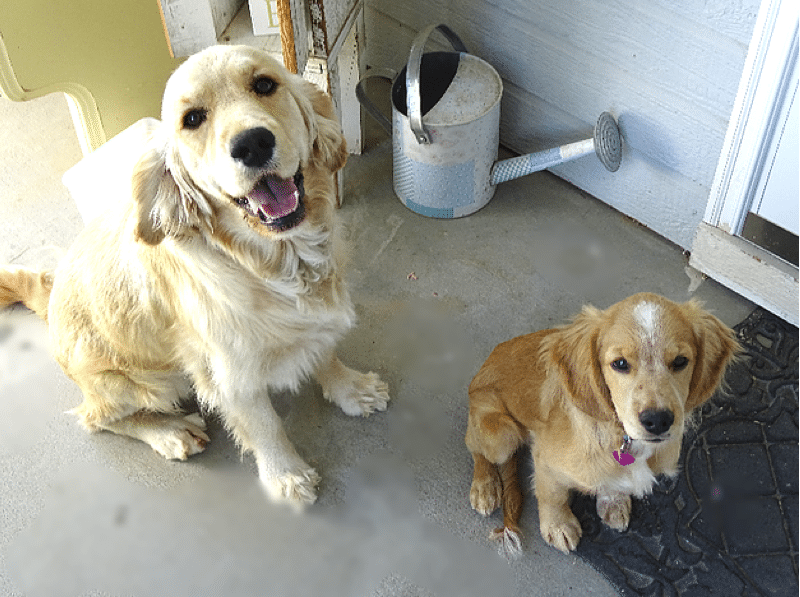
What is the Main Difference Between Standard and Miniature Golden Retriever?
The Golden Retriever is a solid breed, with a history reaching back into the 1800s and recognized by the AKC in 1925 as a distinct breed. Every breeding of a pair of two Golden Retrievers can reliably produce pups that meet the breed standard. Adults can be expected to weigh between 55 pounds to 75 pounds, with females typically weighing in on the lower end and males on the upper end.
The Miniature Golden Retriever was only created recently, in 2003, by Kathy Burgess as a way for those who wanted a Golden Retriever but couldn’t have a dog of that size. The Miniature Golden Retriever is a mix of a Golden Retriever with another, smaller breed – most commonly either a Cocker Spaniel or a Miniature Poodle, although some breeders are also mixing in other small breeds, such as the King Charles Cavalier Spaniel. This is a newer, hybrid breed that has not yet been fully standardized, so there is quite a bit of variation in the dogs being sold as Miniature Golden Retrievers.
While the Standard Golden Retriever is a large dog, the adult Miniature Golden is noticeably smaller. Miniature Golden Retrievers can weigh between 20 pounds to 50 pounds, depending on the breed mix of the parents.
Another significant difference is the coat. Standard Golden Retrievers are well-known for their beautiful, double-thick fur coat – and the major shedding that comes with them. In contrast, the ideal Miniature Golden Retriever will still demonstrate a beautiful golden coat, but with far less shedding.
Comparison of Full-Grown Golden Retriever Sizes
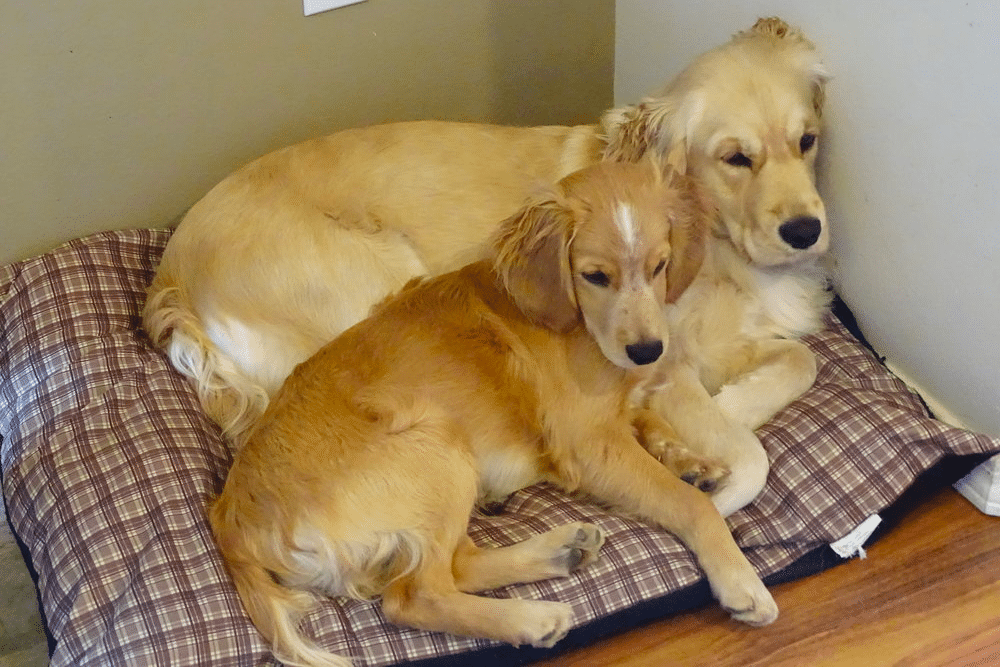
As stated, the adult standard Golden Retriever weighs in between 55 pounds to 75 pounds, while the adult Miniature Golden Retriever weighs in between 20 pounds to 50 pounds.
When measured by height, the Miniature Golden Retriever measures between 12-16 inches at the withers when standing. The withers are the highest point of a dog’s shoulder blades
In contrast, an adult standard Golden Retriever is dramatically taller, measuring between 20 to 24 inches at the withers. As you can see, the tallest Golden Retriever is twice as tall as the shortest Miniature Golden Retriever.
Who is a Miniature Golden Retriever Best For?
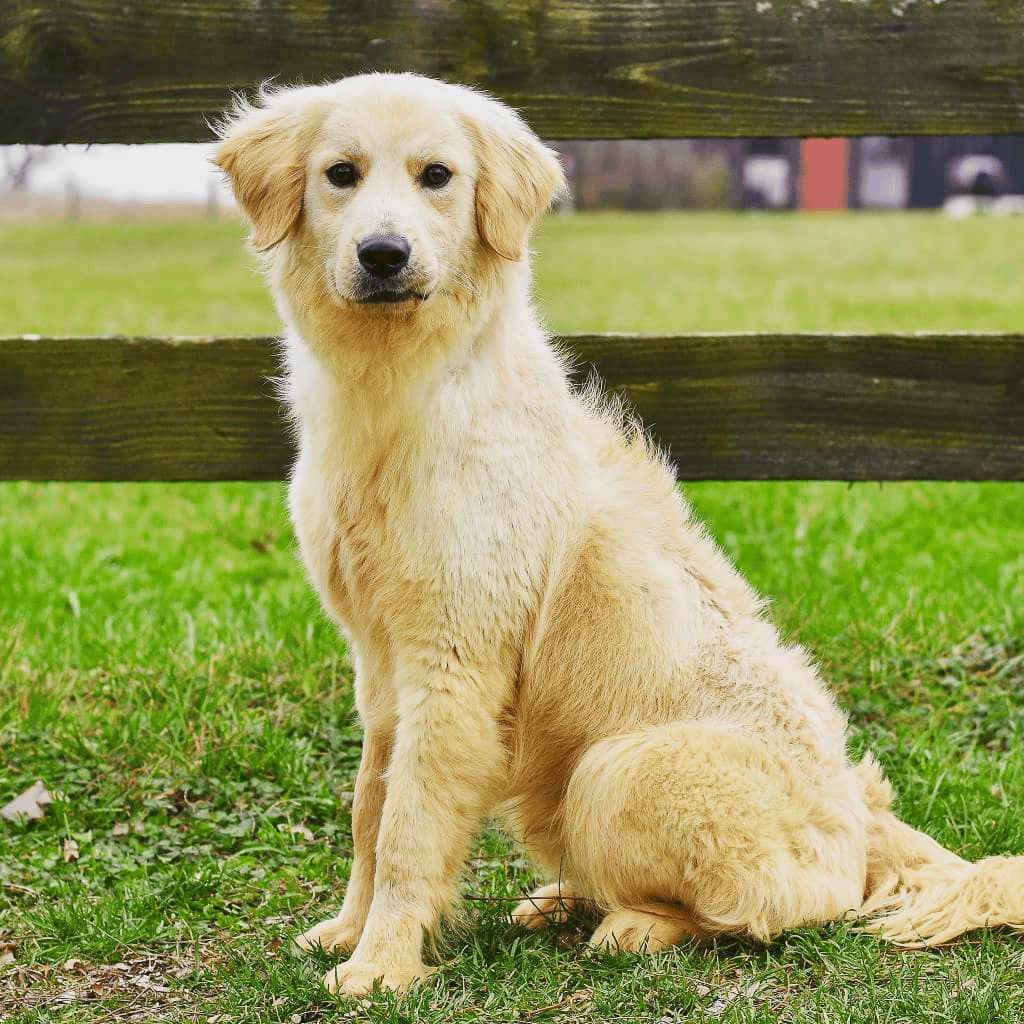
Both the Miniature Golden Retriever and the Standard Golden Retriever are bred to be good companion dogs, with a kind yet playful temperament. But there are some key differences, so when choosing which breed is best suited for your family and your lifestyle, it is important to know those differences.
A Miniature Golden Retriever may be the better choice for you if….
- You prefer a small-to-medium dog
- You prefer a dog that does not shed as much as a Standard Golden Retriever
- You prefer a dog that does not need as much brushing of the coat
- You prefer a dog that may be less likely to trigger allergies in sensitive individuals
- You do not need your dog to be task-trained for mobility work as a service dog
- You do not need your dog to be field-trained to retrieve downed fowl or game
- You are willing to accept that a puppy, when grown, may weigh nearly as much as a small Standard Golden Retriever.
- Want a dog that is likely to live a few years (12-15 years) longer than a Standard Golden Retriever (10-12 years)
- You are unable/unwilling to manage the size and care requirements of a Standard Golden Retriever
Who is a Standard Golden Retriever Best For?
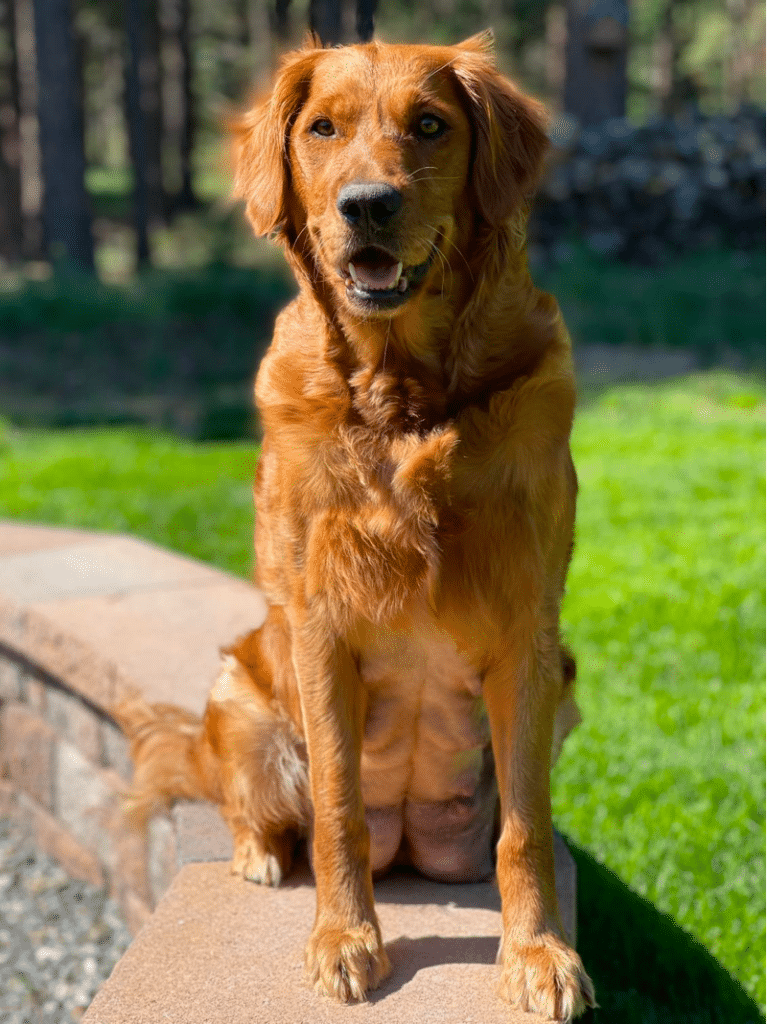
The Standard Golden Retriever is a well-established breed. With very few exceptions, females will weigh between 55-65 pounds and males between 65 – 75 pounds, and there is very little variation within a well-bred Golden Retriever in terms of appearances.
A Standard Golden Retriever may be the better choice for you if….
- You prefer a medium-to-large dog
- You can accept the shedding that comes with a Golden Retriever
- You can commit to properly brushing your Golden Retriever several times a week at a minimum – and sometimes, daily
- You are not prone to allergies
- You have a need for your dog to be a service dog, task-trained for mobility work
- You have a need for your dog to accompany you when hunting, to bring back downed game.
- You are aware that a typical Standard Golden Retriever does not live past 10-12 years of age.
Miniature Vs. Standard Golden Retriever: History and Original Purpose
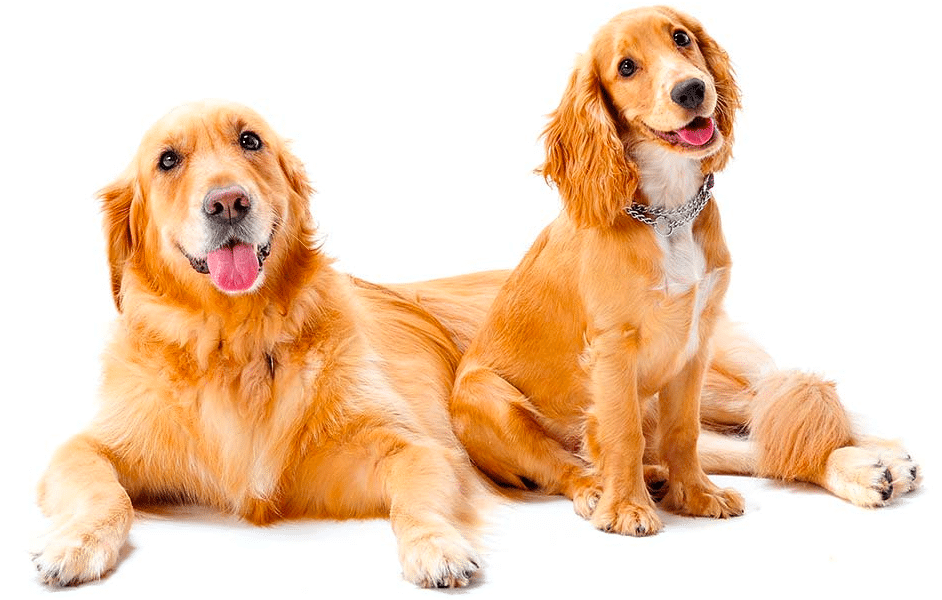
In the 1800s, a Scotsman noticed a single yellow pup from a litter of black Wavy-Coat Retrievers. He raised the puppy, then bred that pup to a liver-colored Tweed Water Spaniel. The offspring included four little yellow-colored puppies. Those four became the foundation stock for what would eventually become the Standard Golden Retriever breed of today, with other breeders adding in a bit of Irish Setter and Yellow Labrador, before the breed was officially established.
The Standard Golden Retriever proved to be a versatile dog, excelling as a family companion dog, a hunting/retrieval dog, and eventually, becoming one of the “Fab 4” in the service dog community – one of the most sought-after dogs for service dog work.
By 1925, the breed had developed enough history and stability that the AKC officially recognized the breed.
In contrast, the Miniature Golden Retriever is correctly considered a hybrid breed, still in development. The hybrid breed first was announced in 2003 and was developed particularly to cater to potential dog owners who are unable to manage the size and care requirements of a Standard Golden Retriever.
One aspect that all breeders agree on is that the Miniature Golden Retriever must look just like a Standard Golden Retriever – but simply on a smaller scale. To achieve that goal, that majority of the parentage needs to be pulled from the Standard Golden Retriever, but the smaller size needs to come from a smaller breed – either a Miniature Poodle and/or a Cocker Spaniel.
At this time, Miniature Golden Retrievers are not recognized by the AKC. However, two other organizations, the Designer Dogs Kennel Club (DDKC) and the Dog Registry of America, Inc. (DRA) do recognize Miniature Golden Retrievers.
Miniature Vs. Standard Golden Retriever: Popularity
The Standard Golden Retriever has ranked in the top breeds for many years, sometimes coming in third for popularity, sometimes fourth. Imagine having all the positives of the Standard Golden Retriever wrapped up in a smaller package – that’s the Miniature Golden Retriever.
The Miniature Golden Retriever is highly desired by those who can’t have the larger Standard Retriever, and as this new hybrid breed becomes more well-known, it may eventually surpass the Standard Golden Retriever for popularity.
Miniature Vs. Standard Golden Retriever: Coat and Coloring
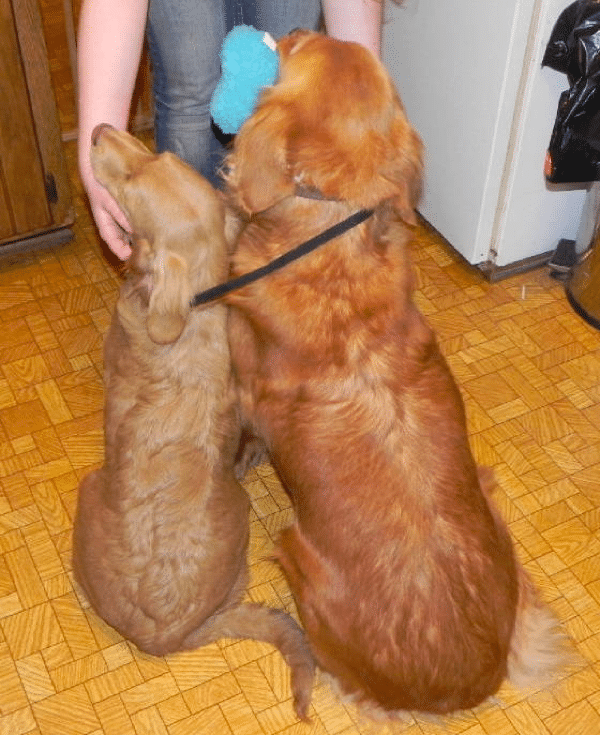
The Golden Retriever comes in a range of hues from pale cream to an auburn red, owing to the influence of the Irish Setter in the foundation gene pool, but the primary color is typically gold.
Likewise, the Miniature Golden Retriever is expected to have the same range of colors, as the hybrid standard is that they should look exactly like Standard Golden Retrievers – just in a smaller package.
In terms of coat, that is where some differences truly become apparent. The Standard Golden Retriever has a luxuriously thick, long, wavy double-coat, perfect for protecting a dog’s skin when working in the field, but a challenge to manage in a household for shedding.
The Miniature Golden Retriever’s coat tends to be slightly shorter, and, depending on the mix of parentage (Cocker Spaniel vs. Poodle), maybe slightly more hair-like and create less shedding. The Miniature Golden Retriever may have either a single coat or a double coat, and it can be straight or wavy, or even wiry.
Miniature Vs. Standard Golden Retriever: Temperament
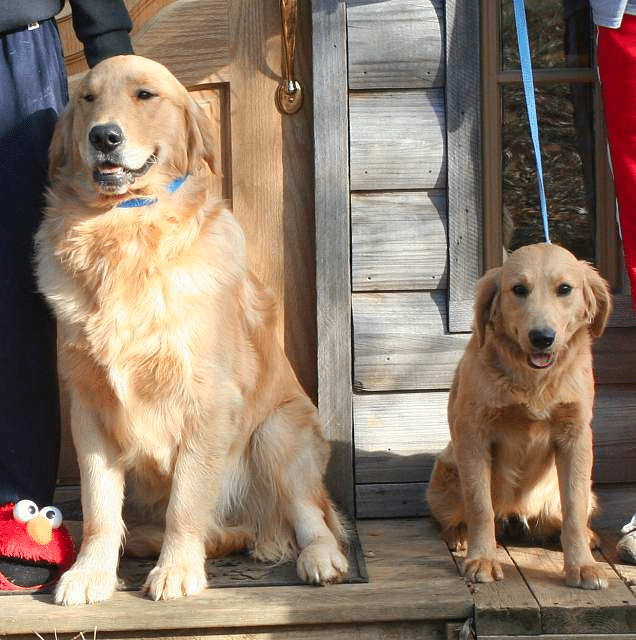
The temperament of the Standard Golden Retriever is well-known and part of their breed standard:
- Friendly
- Reliable
- Trustworthy
In addition, temperament characteristics commonly exemplifying the Standard Golden Retriever include:
- Playfulness
- Alert
- Energetic
- Trainability
- Desire to please people
In contrast, the temperament of the Miniature Golden Retriever has some degree of variation due to the influence of the Cocker Spaniel and the Poodle in their lineage.
While Cocker Spaniels have a coat that most closely mirrors that of the Standard Golden Retriever, Cocker Spaniels, as a breed, have a slight propensity towards being snappish at times and to nip or biting when nervous. Some Poodles have a tendency towards anxiousness, so it is worth meeting the parents before investing in a puppy from a particular breeding.
Nervousness, anxiety, and snappishness are not desirable characteristics in any well-bred dog, including the Miniature Golden Retriever. Accordingly, the best Miniature Golden Retriever breeders are working on ensuring that high-quality dogs with excellent temperaments are used in their breeding programs. Choosing a breeder who is very selective with their breeding choices is key to finding your perfect Miniature Golden Retriever.
Miniature Vs. Standard Golden Retriever: Health Concern
Like many breeds of dogs, both the Standard and Miniature Golden Retrievers love to eat. As the dog’s caretaker, you owe it to your dog to ensure they have high-quality food and are fed an appropriate amount according to their age, size, and activity levels. Good quality food will have an appropriate ratio of protein, carbohydrates, and fats, along with vitamins and minerals. Avoid foods with fillers and food dyes, and always ensure that your dog has access to clean, fresh water.
Always be sure to read the manufacturer’s recommended feeding schedule. The amount of food needed when food is of high quality if significantly less than when feeding lower quality food. While a higher quality food may cost more per pound to purchase, in the end, when following the recommended feeding schedule, the higher quality food will often cost less per serving – and may help prevent health conditions associated with a poor diet.
The Miniature Golden Retriever has a slightly longer average life expectancy than the Standard Golden Retriever. Some health conditions are more common in specific breeds, so it is important to know your dog’s parentage. A canine-DNA service, such as Embark or Wisdom, can be useful to know if your pup is at an increased risk of certain conditions.
Some conditions to be aware of include:
- All Golden Retrievers (Standard and Miniature) are at increased risk of hypothyroidism, hip and elbow dysplasia, lymphoma, and obesity.
- Miniature Golden Retrievers with Poodle heritage may be at increased risk of cataracts, diabetes, and bloat.
- Miniature Golden Retrievers with Cocker Spaniel heritage may be at increased risk of cardiomyopathy, allergies, and kidney stones.
Miniature Vs. Standard Golden Retriever: Trainability
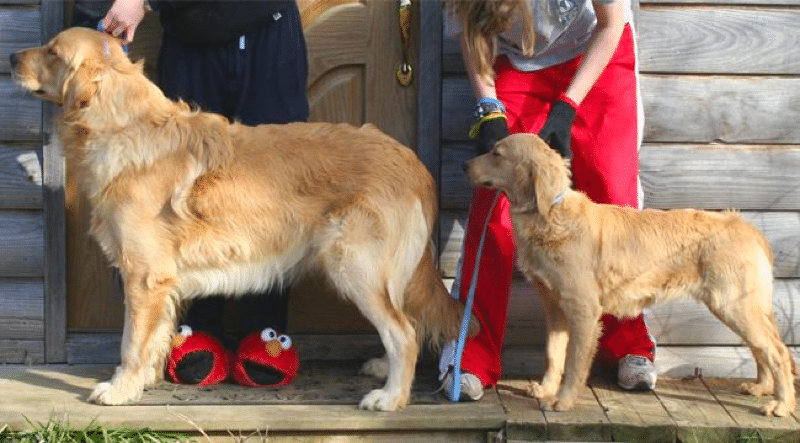
Both the Miniature Golden Retriever and the Standard Golden Retriever are considered highly trainable dogs, smart and eager to please their human, and with the energy to spend in training.
The influence of the smaller breed in the mix needs to be considered as well. Poodles can be stubborn, so positive training techniques are usually best. Aversive techniques should be limited to the most minimal level, and only when needed to ensure the immediate safety of the dog. Otherwise, combine positive training with redirection from unwanted behaviors, and you are likely to have a well-trained and happy dog.
Miniature Vs. Standard Golden Retriever: Exercise and Activity Levels
Both Miniature and Standard Golden Retrievers tend to be high-energy dogs. They enjoy exploring the world and benefit from going on walks and hikes. Don’t forget to engage the retriever instinct by throwing a ball or stick too. Playing fetch, tag, or hide-and-seek are some activities that most Goldens (both big and small) love.
Most Standard Golden Retrievers also enjoy swimming when given a chance. The same may or may not be true with a Miniature Golden Retriever, due to the influence of the smaller breeds in their heritage.
Whether you choose a Miniature Golden Retriever or a Standard Golden Retriever, one thing is certain: this is not a couch potato dog. If you do not give them enough exercise to keep them mentally engaged and physically fit, they WILL find their own way to entertain themselves – and you may not like it how creative they can be.
Miniature Vs. Standard Golden Retriever: Life Expectancy

The Miniature Golden Retriever has a slightly longer average life expectancy compared to the Standard Golden Retriever, by 2-3 years. This is due to the influence of the smaller breeds, which tend to have a longer life than larger dogs.
Standard Golden Retrievers live 10-12 years, while Miniatures live 12-15 years.
You might want to read about What determines a Golden Retriever’s Life Span
Miniature Vs. Standard Golden Retriever: Grooming and Shedding
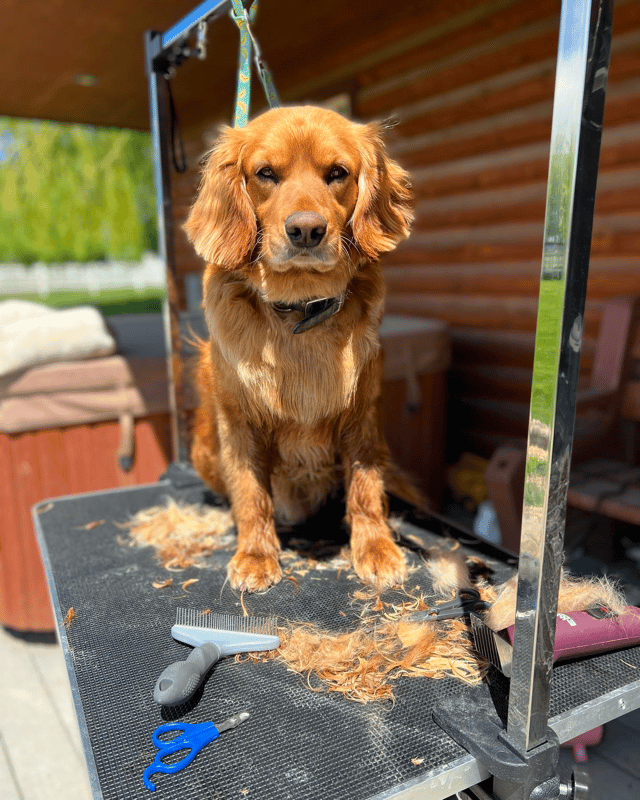
One can’t consider owning a Golden Retriever – Standard or Miniature – without careful consideration of the grooming that a beautiful coat requires. First, to prevent matting, it is important to keep the coat brushed and tangle-free. If it does get matted, do not shave down or clip the coat. Instead, use a canine detangler or conditioner, along with a detangling comb or brush to gently work through the mats.
Ideally, a quick daily brushing will be quite sufficient most of the time. However, there may be times when more than a quick brushing is needed – such as in spring when the winter coat is shed, or, in the case of a dog who retrieves downed fowl or game, who might end up with burrs and field debris worked into the coat. In those cases, carefully bathing and working through the coat will require the right tools and patience.
Daily brushing will help reduce the number of shed hairs left behind by your Golden, whether Miniature or Standard. Miniature Golden Retrievers tend to spread less dander than Standard Golden Retrievers, although to what extent will depend on the breeds used to create your Miniature Golden Retriever.
However, grooming is more than just brushing your dog.
Grooming includes ensuring the nails are properly trimmed; the teeth are cleaned, and the ears are checked and cleaned as well. Like most floppy-eared dogs, Goldens (both Miniature and Standard) are somewhat more prone to ear infections, so at least weekly, take a peek inside those soft ears and check for any built-up wax. If you notice a foul odor, a visit to the vet may be needed to forestall an ear infection.
An ideal grooming schedule is as follows:
| Brushing coat | At least 3x/week; daily is better |
| Brushing teeth | Daily |
| Cleaning in ears | Weekly, after swimming, or as needed |
| Nail trimming | Every 3-4 weeks |
Don’t be too hard on yourself if you aren’t able to match the ideal grooming schedule. Most families are quite busy; but if you do your best to get as close as you can to this schedule, your dog should be perfectly fine.
Miniature Vs. Standard Golden Retriever: Cost
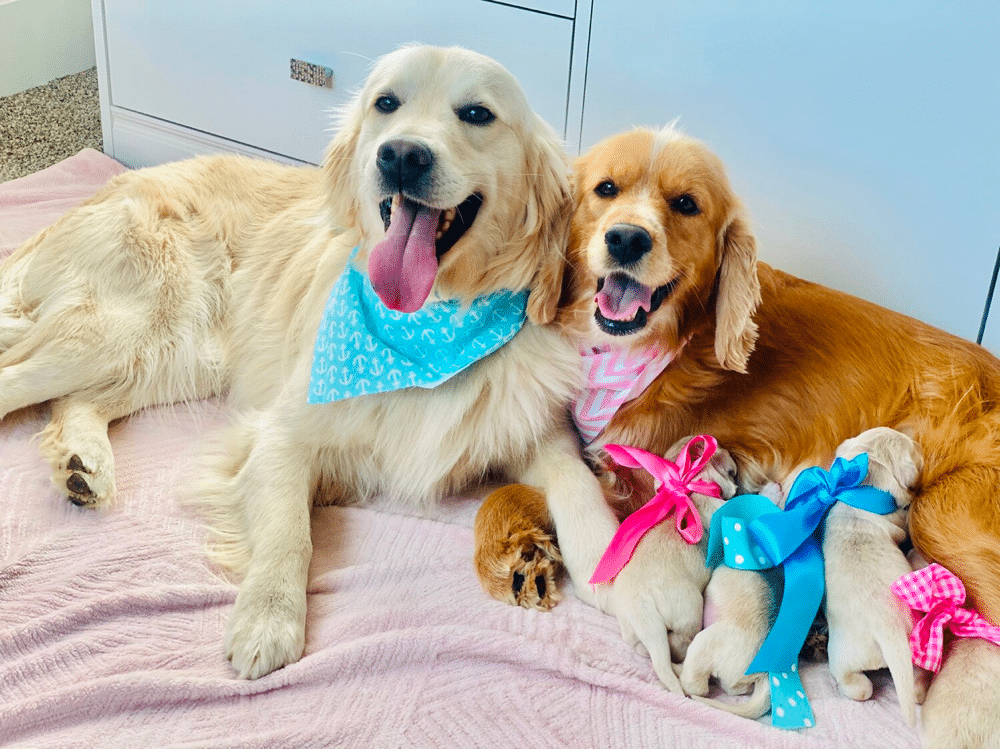
Miniature Golden Retriever prices vary tremendously. On the lower end, you can expect to pay $1,500 – but the quality of the parents (and resulting puppies) may be questionable. On the higher end, expect to pay up to $6,000. At that price point, the breeder should have the parent’s dogs’ OFA (hip/elbow x-rays to check for dysplasia) available and veterinarian evaluations as well.
In comparison, Standard Golden Retriever prices for a companion/family pet tend to be a bit lower, often ranging from $500 to $4,000. It is basic supply-and-demand; there are far more breeders of Standard Golden Retrievers and not many breeders of Miniature Golden Retrievers.
An exception relates to Standard Golden Retrievers trained for service dog work; those dogs can easily cost upwards of $30,000 to acquire due to the extensive training already invested in them.
In addition to the actual purchase price, you should expect to pay for microchipping and registration, a veterinary exam of the new puppy soon after the puppy arrives in your home, standard vaccinations, and, depending on how far away the breeder is, transportation of the puppy from the breeder to your home. Another consideration is pet health insurance. A good policy that has few exclusions is a good idea.
Checkout this post to see our breakdown of the average cost of owning and raising a Golden Retriever from puppy to adult stage.
Final words
Both Miniature Golden Retrievers and Standard Golden Retrievers have the potential to be great companion dogs. Regardless of your decision of which to get, you should plan to enjoy many years with your fun-loving, loyal companion.
